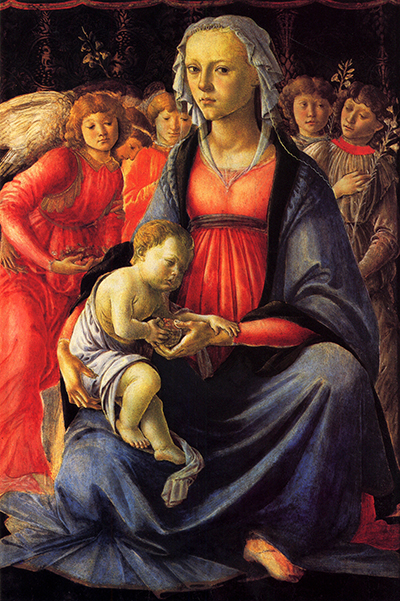This relatively small portrait is believed to be from the career of Sandro Botticelli and is loosely dated at around 1470. The item is now to be found at the Louvre in Paris, France, where it would, no doubt, have undergone scientific research in order to come to that attribution.
The painting captures madonna and child directly in front of us, with the virgin dressed in a red dress with a blue coat over the top. It covers almost all of her body, with just a foot sneaking out at the bottom. The artist places her right in the foreground, enabling us to see the folds of material up close. She wears a small head covering for modesty and places the young child on her right leg. The hold hands together in a comforting gesture but there is none of the eye contact that we find in other madonna and child depictions by Botticelli. Behind we see a large number of figures who have gathered, perhaps for a special event. Angels are represented by large wings and a small background continues above them, though with plain, darkened detail. The artist uses the same tone of colour for several different outfits which has the impact of making the background and foreground connected visually.
No artist has devoted themself to the topic of Madonna and Child as much as Sandro Botticelli. It was initially a result of his early success with this content that encouraged him to continue to work with it. Any artist at the start of their career will be trying to please their patrons, and encourage new commissions until they gain a greater confidence in their own direction. Many are also stuck with their academic training in the early years, before breaking away into their chosen styles after their career has taken off. In Botticelli's case he would actually return to this topic many times, even after he achieved success, though we are unsure as to whether this was by choice, or because new patrons simply wanted something similar to what they had seen from his career already. We have listed all of the major depictions of Madonna and Child that he produced, and attempted to differentiate them as much as possible, though the attributions of some has been brought into question over the centuries, perhaps with involvement from his studio.
Italian art would leave a huge influence on other European nations thanks to the achievements of the Renaissance painters and sculptors. Another notable contributor to the genre of religious art was Bartolomé Esteban Murillo who helped bring innovation to this traditional art form with his own ideas in the 17th century. He brought about a closer connection between humanity and the divine, allowing viewers to feel closer to the iconic figures displayed in front of them. He was mainly based in the city of Seville and found his religious paintings to be most popular locally, with other nations being more interested in his genre paintings that tended to focus on the lives of ordinary people, as shown with the likes of The Young Beggar, Two Women at a Window and The Little Fruit Seller. He was during his own lifetime regarded as the most popular Spanish artist of all.




